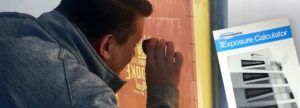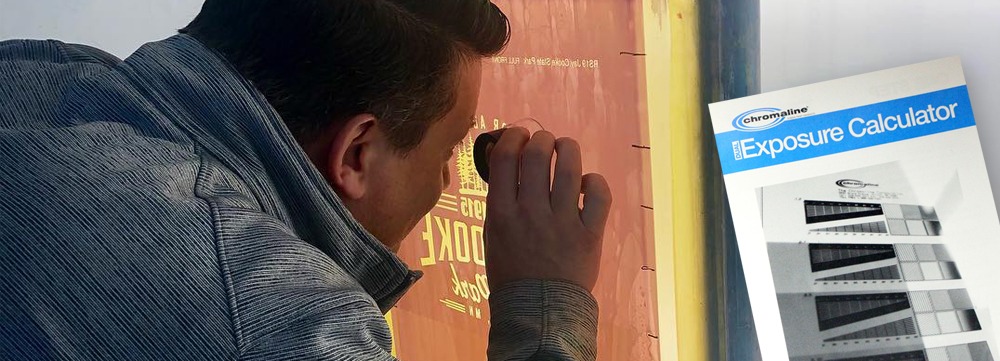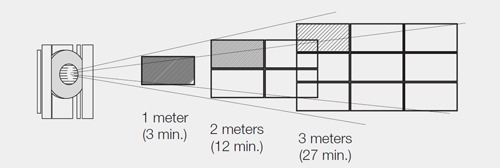
Dial In Exposure Time With Our Dual Exposure Calculator

At least 90% of stencil failures can be traced back to exposure times. If you are having trouble dialing in your exposure times, an exposure calculator can help. Chromaline's Dual Exposure Calculator doubles as a basic Step Test and a One Step Calculator. It was designed to help determine correct exposure time, print quality check and halftone tests. Eliminate miscalculated exposure times and save hours of frustration by following the steps below.
One Step Calculator for Diazo and Dual Cure Emulsions
The left side of the Dual Exposure Calculator is our One Step. It has a special filter that is ideal for diazo and dual cure based emulsions. Click here to watch Mick demonstrate how to use the Dual Exposure Calculator for determining best exposure.
- Place calculator on the coated screen with the emulsion side of the film in direct contact with the emulsion on the screen. The small filter on the calculator must not come in contact with the emulsion on the screen. This will ensure that the calculator will be emulsion-to-emulsion.
- Expose the screen for twice the time you estimate is the correct exposure time for your UV lamp. Record this time and call it the TEST EXPOSURE TIME.

- Develop the screen, then dry as normal. Wet screens will be swollen and misleading.
- Study the line resolution targets on stencil to determine correct exposure time. Look at each pair of line resolution targets and pick the clearest, sharpest image. Record the number in-between the best pair and go to step 5. Note: If it is impossible to choose a “best” pair of images, do one of the following things, depending on what you see. If all line resolution targets are “washed away,” start over at step 1 and double your original test exposure time. Record the new, longer exposure time. Note: Sometimes you won’t find a pair of targets with clear, sharp lines. For example, targets numbered 0.50 may be too filled in and targets numbered 0.33 may be too washed away. Use a number that would be in-between the targets that weren’t quite right. In the example given, 0.40 would work to give the correct exposure time.
- Use this formula to determine correct exposure time:

Step Test Calculator for Photopolymer Emulsions
The right side of the Dual Exposure Calculator is ideal for photopolymer emulsions. Click here to watch Mick demonstrate how to use the Step Test Exposure Calculator.
- Place the Chromaline Exposure Calculator emulsion side against the coated screen. Use cellophane tape to hold it tight to the screen.
- Determine a base exposure to start with. This is an educated guess. For example: You think that the emulsion you are using will expose in 30 seconds. Expose the screen to the UV light source, for 30 seconds.
- Next, cover up image #2 through #5 with a black UV opaque paper and expose the Chromaline Exposure Calculator (do not remove the taped calculator from the screen). Re-expose the calculator for X amount of time (say, 10 seconds).
- After the exposure, move the paper down to the next step #3 and expose again for 10 seconds. Repeat again on the next step #4.
- You’re done. What you will end up with is a screen with 5 exposures of 30 seconds #5, 40 seconds #4, 50 seconds #3, 60 seconds #2 and 70 seconds #1.
- Develop the screen and examine the image. Select the image that looks the best. For example, if #4 looks best, 40 seconds is your exposure. If they are all closed up the test must be redone at a shorter base time. If they all wash away the base time must be increased.
How Lamp Distance Affects Exposure
The relationship between lamp distance and exposure time is this: As lamp distance increases, exposure time increases in proportion to the distance squared. For example, if exposure time is 3 minutes at one meter, then exposure time will be four times that amount (12 minutes) at two meters’ distance and nine times that amount (27 minutes) at three meters.


Contact Chromaline Screen Print Products
Screen exposure problems can be one of the most frustrating issues in the screen printing process. If you have any further questions about how to determine exposure time using our Dual Exposure Calculator, please contact the team at Chromaline Screen Print Products today or find a distributor in your area.
